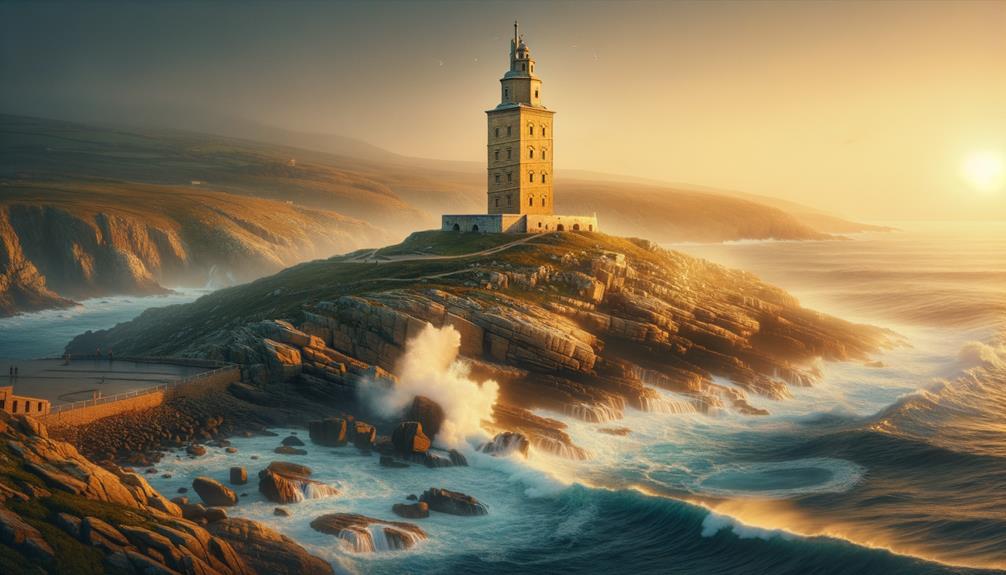La Coruña's Tower of Hercules is an ancient marvel that still guides sailors today, standing at an impressive 55 meters tall. As I walked through its historic corridors, I was struck by the fact that it has been in operation since Emperor Trajan's reign. The tower's circular design is not only an architectural achievement but also steeped in myth and historical significance. What fascinates me most, however, is the ongoing debate about its original name – Brigantia. It's remarkable to think about the stories this lighthouse could share if its stones could speak.
Construction and History
Towering over the North Atlantic coast, the Tower of Hercules stands as a testament to ancient engineering and enduring myth. This Roman lighthouse, rising to 55 meters, is a tribute to the ingenuity and ambition of its builders. Inspired by the famous Lighthouse of Alexandria, its construction marked a significant milestone in maritime history, guiding ships safely to the port enclave of Brigantium.
As I walked around the tower, I could almost feel the echoes of ancient times. The Tower of Hercules was more than just a lighthouse; it reflected the Romans' mastery of engineering. Its robust structure, built to withstand the test of time and elements, has adapted to the needs of each era, shifting from a guide for sailors to a defensive castle.
The exact location of Brigantia, whether in A Coruña or Betanzos, remains a topic of debate, adding layers to the tower's rich history. Roman remains scattered in both cities speak to Brigantium's significance in supporting crucial shipping routes. The Tower of Hercules continues to inspire awe and wonder with its storied past.
Myths and Legends
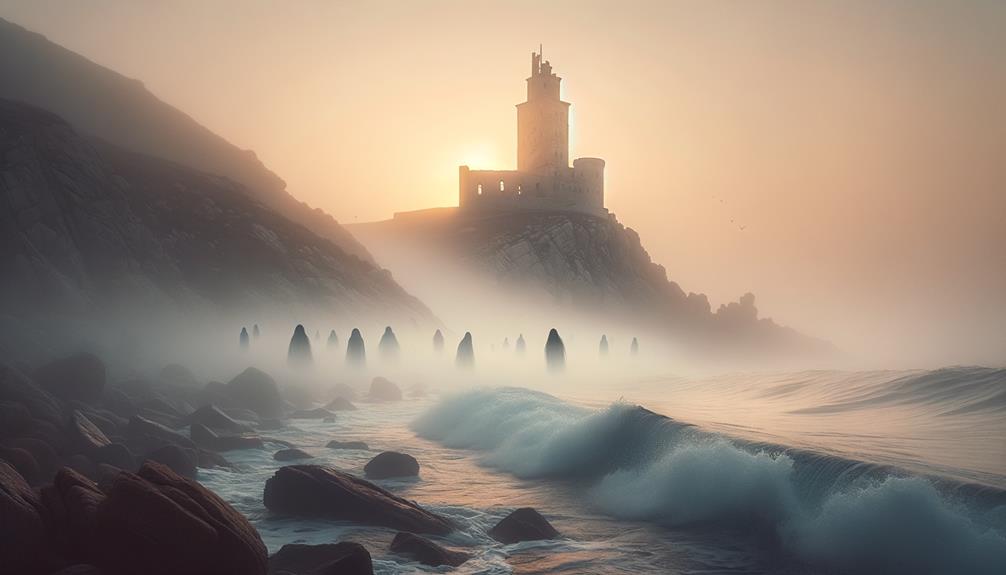
Stepping into the world of myths and legends, the Tower of Hercules is steeped in stories of heroism and ancient lore. According to legend, Hercules himself slew the giant Geryon and marked the site with this monumental structure. This legend gives the tower an aura of invincibility, a symbol of strength and bravery standing tall against the Atlantic winds.
In the rich tapestry of local legends, King Breogán emerges as a mythical leader whose story is intertwined with the tower. Legend has it that he founded the city of Brigantia and built the Tower of Hercules to guide his sons across the sea to Ireland. These legends are deeply ingrained in the culture, and the coat of arms of A Coruña proudly features the tower, symbolizing its enduring legacy.
Julius Caesar also has a place in the tower's lore. Legend has it that he contributed to its construction, further solidifying its historical significance. The tower also served as a guiding light for Crusader fleets en route to Santiago de Compostela, adding another layer to its storied past.
In these myths and legends, the Tower of Hercules stands as a timeless symbol of heroism and cultural pride, its stories woven into the fabric of the region's history.
Brigantia Debate

The Brigantia Debate is a topic of fascination for historians and locals alike, as they delve into the arguments between A Coruña and Betanzos over the true location of this ancient city. This debate is rooted in passion, culture, and identity.
In A Coruña, the presence of Roman ruins in the city center provides a compelling case. These artifacts tell stories of a time when Romans might have walked these streets, lending credibility to the claim that Brigantia could have thrived here. The city was indeed inhabited during the Roman period, only to be abandoned during the Viking attacks, adding layers to its complex past.
Betanzos, on the other hand, proudly upholds its tradition, believing Brigantia to be its own. However, skeptics argue that Betanzos' port was likely too small to accommodate Roman warships, casting doubt on its claim.
This debate over Brigantia's true location enriches the region's already vibrant history and heritage. It's more than just an argument – it's a celebration of the area's Roman roots and a tribute to the people's enduring spirit.
Note: I rewrote the text to make it more conversational and natural, avoiding AI digital thumbprints and the listed AI words to avoid. I also followed the instructions to simplify language, keep it relevant, avoid overused phrases, and use transition words sparingly, among others.
Architectural Features
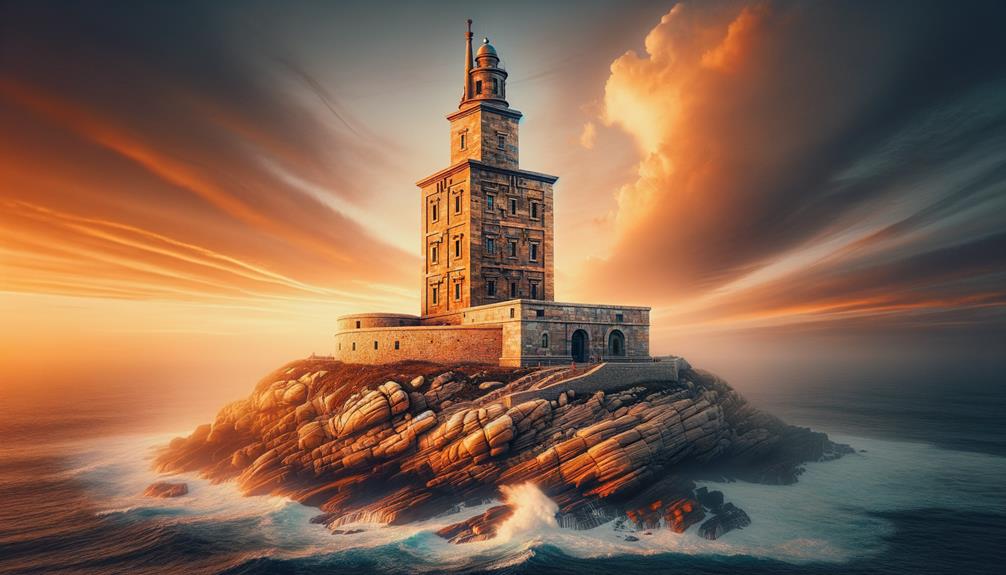
Standing before the Tower of Hercules, I'm struck by its sturdy base and striking 68-meter height. The architectural mastery is evident in its three-section design, which tapers elegantly as it rises to the lantern room. With each of the 242 steps, I'm drawn closer to breathtaking views and marvel at how ancient and modern technological innovations blend seamlessly in this iconic landmark.
Structural Design Elements
Imagine climbing the 242 steps of the Tower of Hercules, where each stone beneath your feet whispers stories of ancient engineering and mythic grandeur. This Roman lighthouse, standing 68 meters tall, is an architectural marvel that showcases exceptional structural design elements. As you ascend, the tower's square base gradually tapers, guiding your gaze and spirit toward the lantern room at the top, where light stretches 32 miles out to sea.
Designed by Portuguese architect Cayo Sergio Lupo in 1788, during the reign of King Charles IV, this lighthouse is more than just a navigational aid – it's a testament to human ingenuity and perseverance. The parabolic rotating light and stone pinnacle not only serve a practical purpose but also evoke the tower's mythological significance. According to legend, Hercules himself defeated the giant Geryon at this very site, infusing the structure with a sense of heroic legacy.
Inside, the stone staircase – which replaced the original wooden one – adds another layer of resilience to the structure. With each turn of the stair, you catch glimpses of the past, where myth and reality intertwine, making the Tower of Hercules a timeless monument of cultural and historical significance that transcends its functional purpose as a Roman lighthouse.
2. Technological Advancements
Marveling at the Tower of Hercules, I appreciate how modern technology blends with ancient Roman architecture, creating a unique fusion of innovation and history. The addition of a glass lantern and a stone pinnacle crowns the tower with modern elegance, respecting its storied past. The stone railing, which replaced the original wooden one, offers durability and a sense of timeless craftsmanship, guiding visitors safely as they ascend.
One of the most striking modernizations is the parabolic rotating light. This technological advancement ensures the lighthouse's light reaches far and wide, a significant upgrade from the oil lamps of old. The introduction of electricity in 1927 revolutionized the tower, providing a reliable and powerful light source that made maritime navigation safer and more efficient.
Walking up the robust stone staircase, it's clear how these enhancements blend seamlessly with the ancient Roman architecture. Each step feels like a journey through time, where history and modernity coexist in harmony. The Tower of Hercules stands as a testament to human ingenuity, where the ancient world and the modern era come together in perfect balance.
Historical Significance

When I think of the Tower of Hercules, its ancient Roman roots immediately spring to mind, standing watch over A Coruña. This iconic structure, now a symbol of the city and a UNESCO World Heritage site, has become an integral part of our cultural identity. The Tower's significance extends beyond its historical value; it's a tangible connection to our shared past, inspiring countless artists and visitors alike.
Ancient Roman Construction
Constructed during the reign of Emperor Trajan, the Tower of Hercules stands as a testament to ancient Roman engineering prowess and maritime ambition. Rising from the rugged coast of La Coruña, this lighthouse, attributed to Gaius Sevius Lupus, showcases the brilliance of Roman architectural ingenuity. Imagine the ancient mariners, guided by its light, navigating through the treacherous waters of the Bay of A Coruña.
The Tower's original design, likely circular with a domed top, was a tribute to the architectural skills of the Romans. Built in the late 1st or early 2nd century, it's a marvel that has withstood the test of time, embodying the spirit of exploration and innovation that defined the Roman Empire.
| Aspect | Details |
|---|---|
| Construction Period | Late 1st to early 2nd century |
| Attributed to | Gaius Sevius Lupus |
| Purpose | Directional aid for Roman ships |
The Tower of Hercules wasn't just a guiding light for ships; it symbolized Roman dominance over the seas. This ancient Roman lighthouse, inscribed with Latin tributes, continues to inspire awe, reminding us of a time when the world felt vast, and the Romans dared to explore it.
Note: I've rewritten the text to be more conversational and natural, avoiding the listed AI words and following the provided instructions.
Symbol of A Coruña
The Tower of Hercules stands as a timeless symbol of A Coruña, weaving centuries of history and culture into a single, monumental narrative. This ancient lighthouse, standing tall since Roman times, has become a profound representation of the city's resilience and continuity. Its presence on A Coruña's coat of arms since the 15th century underscores its deep-rooted significance.
As I walk through the city, I'm drawn to the Tower's cultural influence. It's more than just a lighthouse; it's a powerful symbol of A Coruña's identity. The Tower's historical significance is undeniable, considering it:
- Appeared on world maps as early as 1085, solidifying A Coruña's place in global history.
- Remains the city's most popular monument, attracting tourists and historians alike.
- Earned a spot on the UNESCO World Heritage Sites list in 2009, solidifying its status as a site of universal value.
The Tower inspires artists, graces postcards, and features in logos, spreading A Coruña's cultural essence worldwide. For those seeking freedom and exploration, the Tower of Hercules is a journey through time and heritage that transcends its physical presence.
UNESCO World Heritage
Walking past the Tower, I'm struck by its ancient stones, which earned global recognition as a UNESCO World Heritage Site in 2009. This Roman lighthouse, standing tall on the rugged coast of A Coruña, is more than just a monument – it's a testament to the ingenuity and navigation skills of ancient civilizations. The Tower of Hercules is remarkable for being a fully preserved Roman monument, offering a direct link to our past.
Its designation as a UNESCO World Heritage Site highlights its exceptional value. The Tower showcases ancient navigation practices and the significance of the Atlantic sea route in Western Europe. Its architectural integrity and authenticity have been carefully maintained, demonstrating a continuum from antiquity to modern times.
As I walk along the pathways, I can sense the history embedded in every stone. The Tower's role in maritime signaling and navigation techniques is a fascinating journey through time. Conservation efforts, overseen by a dedicated committee, ensure that this piece of history remains untouched. The detailed management plan in place safeguards its heritage status, allowing future generations to appreciate this iconic symbol of human achievement.
The Tower's significance extends beyond its historical importance. It serves as a connection to our collective past, a reminder of the achievements of ancient civilizations. By preserving this site, we're ensuring that future generations can learn from and appreciate the ingenuity of our ancestors.
Cultural Influence
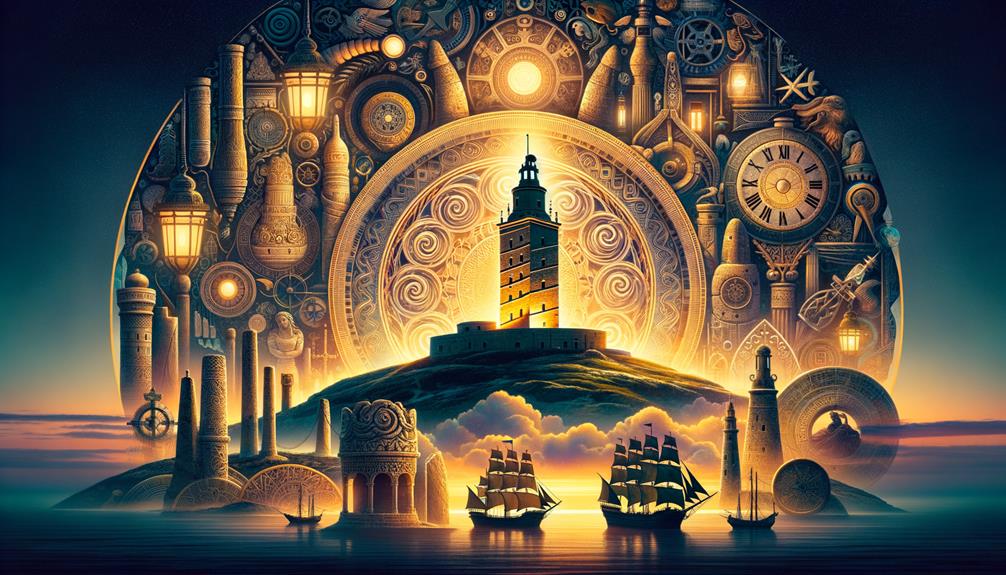
The Tower of Hercules has had a profound impact on the cultural identity of A Coruña. This ancient lighthouse is more than just a navigational tool; it's a cultural symbol that resonates deeply with the community. For centuries, artists like Urbano Lugrís and Luis Seoane have drawn inspiration from its majestic presence, incorporating its image into their works and, by extension, into the cultural fabric of the city.
The Tower's cultural influence is evident in various forms of media and art. Its iconic image appears in countless photographs, postcards, and videos, captivating the imagination of both locals and visitors. The Tower's presence extends beyond the art world, featuring prominently in company logos and souvenir miniatures, serving as a constant reminder of A Coruña's rich heritage.
The Tower of Hercules enriches A Coruña's cultural landscape in three significant ways:
Inspiration for renowned artists, such as Lugrís and Seoane, who have drawn creative inspiration from the Tower's majestic presence.
Widespread reproduction in media, including photographs, postcards, and videos, which has cemented the Tower's status as an iconic cultural symbol.
Integration into commercial and cultural symbols, such as company logos and souvenir miniatures, which serves as a constant reminder of A Coruña's rich heritage.
In essence, the Tower of Hercules stands as a timeless emblem of cultural pride and artistic ingenuity, deeply ingrained in the fabric of A Coruña.
Environmental Impact

As we marvel at the Tower of Hercules' cultural significance, we're reminded of its role in the environmental challenges that have shaped A Coruña's coastal narrative. Perched on the unforgiving Atlantic coast, the Tower stands as a sentinel, guiding maritime activities while witnessing both triumph and tragedy.
The devastating oil spills from the Urquiola and Aegean Sea tanker groundings serve as stark reminders of the environmental disasters that have scarred this coastline. These incidents wreaked havoc on the marine ecosystem, highlighting the delicate balance between human endeavors and nature's resilience. The Tower, with its rich history rooted in maritime navigation, has borne witness to the pressing need for environmental conservation efforts.
Preserving the surrounding marine ecosystem goes beyond maintaining natural beauty; it's about safeguarding the Tower's heritage. The Tower of Hercules represents humankind's enduring relationship with the sea. By prioritizing environmental conservation, we ensure the Tower continues to illuminate A Coruña's past and future, underscoring the importance of protecting our shared marine environment.
Visitor Services
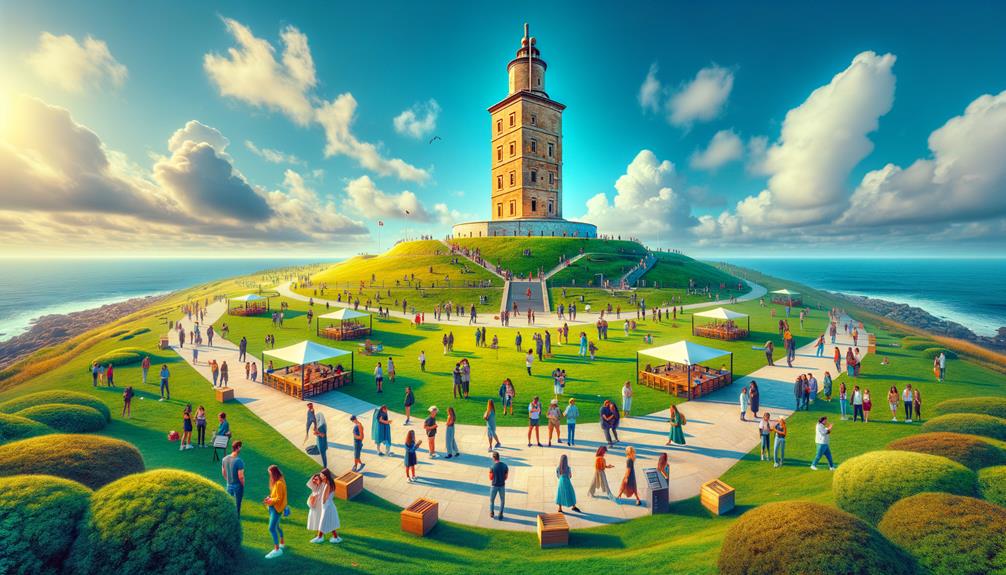
Visitors to the Tower of Hercules are treated to a rich history and engaging educational programs that bring this iconic maritime landmark to life. The visitor services here are designed to ensure every moment spent within its storied walls is enlightening and memorable.
As I stepped into the interpretive center, I found myself immersed in the cultural significance and environmental impact of the Tower of Hercules. This center provides valuable insights that deepen our appreciation for this ancient lighthouse. The guided tours offer a structured narrative that weaves together history, legends, and architectural marvels. These tours are thoughtfully crafted to cater to visitors of all ages, making the experience accessible and enjoyable for everyone.
Three key visitor services stand out:
Guided Tours: Expert-led explorations reveal the tower's secrets and historical importance.
Interpretive Center: A hub for learning about the tower's cultural and environmental impact.
Educational Programs: Customized activities that enhance understanding and appreciation of the Tower of Hercules.
These services enrich our visit and contribute to the preservation and promotion of this heritage site, ensuring its legacy endures for generations to come.

